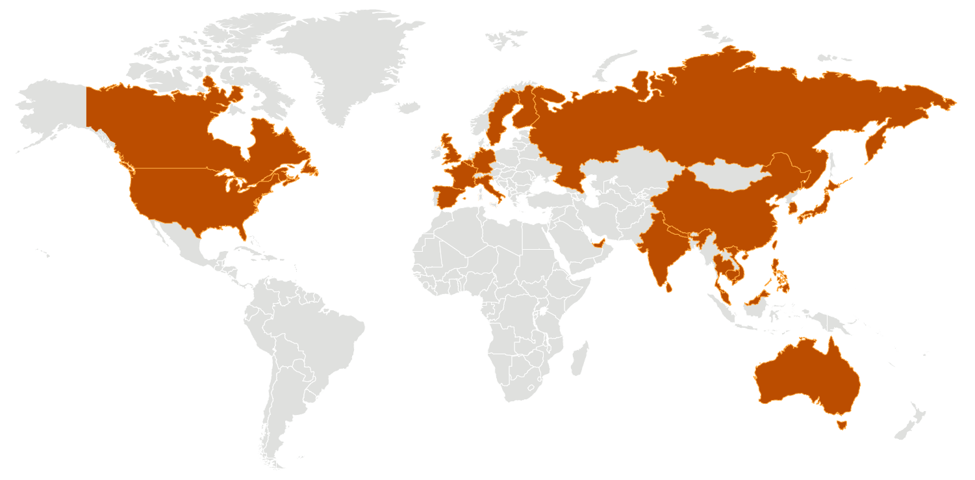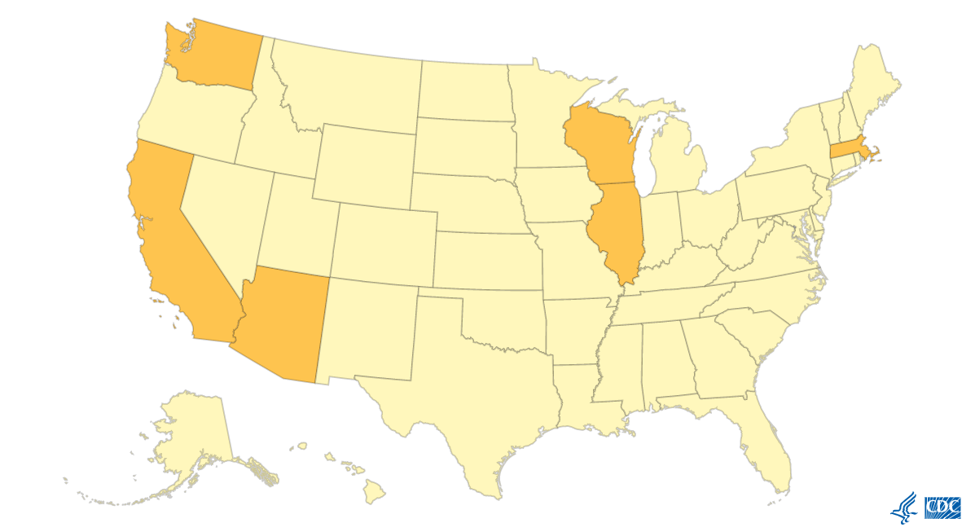By Devina Thiono
Earlier this year, there was a pneumonia outbreak in Wuhan, China. It was later found that the outbreak was caused by a new type of virus that is now named 2019 Novel Coronavirus (2019-nCoV). The symptoms began with fever, coughing, and shortness of breath, which may arise 2-14 days after initial exposure to the virus. If left untreated, it can progress to pneumonia, kidney failure, and death. In China alone, the total number of cases is already over 20,000 with 425 deaths as of early February. This number is increasing daily and for an up-to-date number, you can see it here. However, it is important to note that this is not the first time that a coronavirus presents itself in the community.

Countries with confirmed 2019-nCoV cases. Source: https://www.cdc.gov/coronavirus/2019-ncov/locations-confirmed-cases.html#map
Coronavirus gets its name from the spikes on its surface that look like a crown, or Corona in Latin. In order to survive, coronaviruses need to live in a host – can be humans or animals. Those that infect humans have been adapting with us for a very long time and usually cause the common cold. However, the three most recent coronavirus outbreaks have been caused by coronaviruses that gained the ability to jump between animals to humans, a process called zoonosis.
 The SARS-CoV epidemic in 2003 is thought to originate from infected animals (most likely bats) that spread the virus to other animals (civet cats) and made the jump to humans. The epidemic affected around 8,100 people and resulted in 774 deaths. The MERS-CoV outbreak in 2012 is thought to make its way from bats to camels to humans. Meanwhile, 2019-nCoV is associated with people who have been in contact with seafood and the live animal market in Wuhan. A recent article suggested that the original host of this virus is also bat, since 2019-nCoV shared 88% similarity with two bat-derived SARS-like coronaviruses. In terms of its similarity to its cousins, 2019-nCoV is about 79% similar to SARS-CoV and around 50% similar to MERS-CoV.
The SARS-CoV epidemic in 2003 is thought to originate from infected animals (most likely bats) that spread the virus to other animals (civet cats) and made the jump to humans. The epidemic affected around 8,100 people and resulted in 774 deaths. The MERS-CoV outbreak in 2012 is thought to make its way from bats to camels to humans. Meanwhile, 2019-nCoV is associated with people who have been in contact with seafood and the live animal market in Wuhan. A recent article suggested that the original host of this virus is also bat, since 2019-nCoV shared 88% similarity with two bat-derived SARS-like coronaviruses. In terms of its similarity to its cousins, 2019-nCoV is about 79% similar to SARS-CoV and around 50% similar to MERS-CoV.
Viruses continually try to outsmart the immune response of the host so it can survive under different conditions. Coronaviruses are particularly good at adapting to new environments by constantly changing themselves. When the right changes happen, these viruses are able to infect and survive in a new type of host (animal to human).
Once 2019-nCoV makes its way to the human population, it spreads from person-to-person through respiratory droplets from coughing or sneezing or by touching an object that has been recently contaminated by the virus. Hence, it is important to cover your mouth and nose when sneezing and to wash your hands!
Even though it seems that everyone is currently dreading 2019-nCoV, to put things into perspective, the fatality rate due to 2019-nCoV is currently predicted to be around 2%, which is less than SARS (10%) and MERS (37%). In the United States, so far, there have been only 11 confirmed cases of 2019-nCoV. However, the flu has affected around 15 million people since October 2019.

States with confirmed 2019-nCov cases are shown in dark yellow. Source: https://www.cdc.gov/coronavirus/2019-ncov/cases-in-us.html
A vaccine against 2019-nCoV is still being developed, and current treatment is based on supportive care to help relieve the symptoms. Meanwhile, a vaccine for the flu, which is a more prevalent problem in the U.S. is available!
There have been many reports on the shortage of surgical masks due to the fear of contracting 2019-nCoV. Masks may help to limit the virus spread from person-to-person in high-risk areas, especially if worn by those who are infected. However, for those who live in the United States, the best way to prevent 2019-nCoV, and also the flu, from spreading is still by regular hand washing, covering mouth and nose when coughing or sneezing, thoroughly cooking animal products and avoiding being in contact with those who are showing symptoms of respiratory illness.
Edited by Rachel Cherney and Sarah Brotman
